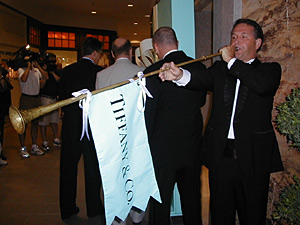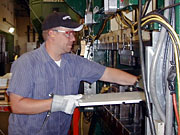Part 2: "An almost two-tiered economy"
September 14, 2004
 |
| At the end of July, Minnesota's first Tiffany & Co. store opened to great fanfare in the Minneapolis suburb of Edina. (MPR Photo/Jeff Horwich) |
Minneapolis, Minn. — The investment firm Lowry Hill sits 53 floors up in Wells Fargo Center. These investment professionals are at the peak of their field, and they're not here to look after your 401K.
"We manage money for about 300 families," says investment principle Martha Pomerantz. "A new family relationship requires $10 million of investable assets." Pomerantz says the average Lowry Hill client has about $20 million invested.
 | |||
If you're like most people invested in the stock market, right now your nest egg looks about the same or smaller than it did five years ago. Lowry Hill investors felt the pain, too; Pomerantz says some accounts were down a million dollars or more at one point. But that pain is in the past.
"A lot of it is behind us," Pomerantz says. "I think this last year, when we had that nice upturn in 2003 was great because we gained a lot of that value back, that felt really good."
In some cases, it felt great.
Consider one type of investment: stock in small companies, known as "small caps." Small cap stocks have been among the better bets in the past five years. If you'd put your money in a general selection of them, as many investors do, it would have increased by about one-third.
Not bad, until you consider that Lowry Hill's skilled stock pickers helped their small cap investors more than double their money over that time.
Not only does that feel good, it feels better than the average investor, and far better than the one-half of households that own no stock at all. A cut in dividend taxes last year made the market even sweeter. It may not be the high-flying stock market of 1999. But from up here on the 53rd floor, it sounds like a recovery.
"A great client base that exists in this market"
Flanked by costumed trumpeters, the doors opened this summer at Minnesota's first Tiffany & Co. store, inside a posh Edina shopping center. On the first day, the showroom is packed with invitation-only guests. A saleswoman shows off one cabinet: Money-clips, necklaces, and watches from $1,000 to $10,000.
"We have a great client base that exists in this market," says store director Kathy Buchanan. "Many of these people have been shopping in some of our other locations and on the Internet, so we know we already have a great base here."
 | |||
Also in the crowd, over by the string quartet, is Tiffany's central region vice president, Suzanne Halmi. She's careful to point out Tiffany's has customers in many price ranges. But the core Tiffany's clientele is exactly what they followed to Edina.
"I've been reading a lot about the economy," Halmi says. "A lot of affluent people are still spending at luxury retailers. They're not as hit by the economy."
In the first half of the year, Tiffany's same-store sales rose 14 percent in the U.S. Compare that with Wal-Mart, where U.S. sales in the same period rose just five percent. The discount retailer recently lowered its outlook for the second half of the year. Sears saw sales fall six percent in August.
Wells Fargo's Sung Won Sohn says these are not isolated examples.
"Discount stores have not fared very well," Sung says. "Whereas department stores -- Saks Fifth Avenue, Nordstroms, Niemann Marcus -- they seem to be doing quite well. Why? Because the people at the high end of the income spectrum, they seem to be doing better in part because of bonuses, but also stocks and bonds have been up and increased their assets. Therefore they are likely to spend money."
"People are willing to pay the extra dollars"
The economic recovery also seems alive and well in The Pines -- a new development in the wealthy St. Paul suburb of North Oaks.
Sherry Nelson, with the builder Kootenia Homes, leads the way through the "great room" and into the gourmet kitchen of a model -- a two-bedroom, free-standing townhome, partly designed for empty-nesters who might be looking for something a little smaller.
 | |||
"They are considered upper-bracket. Starting point in here would be probably low-fives, and they can go up to whatever you want to get them up to," Nelson says.
And demand?
"There are plenty of people," Nelson says. "It's in demand all over the (Twin) Cities. There is not a problem with anybody or anything as far as the need for this."
Low interest rates sustained a housing boom right through the recession, and contributed to the overall recovery. If you owned a home in the right place, selling could bring a big financial boost and a chance to trade-up. Down the street from the model, Ellen and Dennis Caughey are moving in to their new home in The Pines, leaving a house in another nearby suburb they bought decades ago.
"In our previous neighborhood, our house was supposed to go on the market on a Sunday. It sold on Saturday night," Ellen Caughey says. "In that market, location was everything."
Did she feel they did well on the deal? "Oh, yes," she says. "Our asking price, there was no negotiation."
|
Average hourly earnings have not been keeping up with inflation. In fact, they've been falling behind.
- Sung Won Sohn, Wells Fargo chief economist |
Dennis Caughey has begun to get to know the neighborhood. "A number of 3M-type people have bought in here," he says. "They're affluent-level -- the engineers, the management people. I think the big thing is, people are willing to pay the extra dollars that a development like this costs."
At this point in our search for the economic recovery -- between the exclusive investment house, the ritzy retailer, and the upscale suburban development -- you're probably noticing a pattern.
"Certainly not everyone has been benefiting from this recovery equally," says Wells Fargo's Sung Won Sohn. In general, Sung says if you had more wealth going into the downturn, you're feeling a bigger bounce coming out of it.
Many people working for an hourly wage, on the other hand, are still waiting for improved growth and profits to be passed along to them.
"Average hourly earnings have not been keeping up with inflation. In fact, they've been falling behind," Sung says. "Also, they also don't tend to own expensive homes and stocks and bonds, etcetera. The fact that they do not own appreciating assets has hurt them as well. So this creates a kind of appearance and even the reality of an almost two-tiered economy."
Of course, Dr. Sohn would be the first to tell you the recovery is far more complex than the rich getting richer. And that's where we go from here: Into the vast middle ground of companies and individuals whose experiences depend on where they sit in the economy, and how they've prepared themselves to succeed.
Part 3: "A whole lot better than it was a year ago"
|
News Headlines
|
Related Subjects
|

